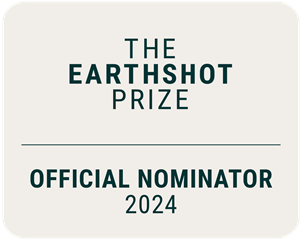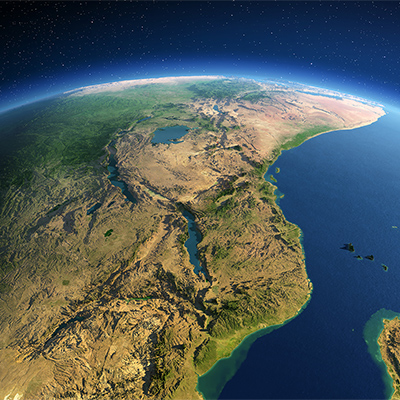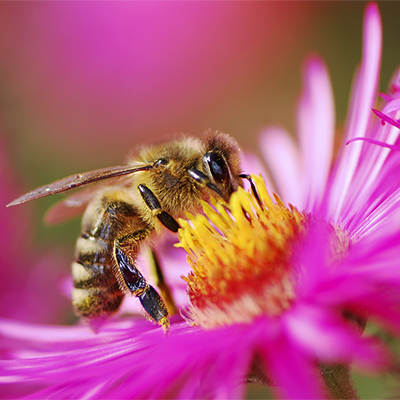Cranfield University is proud to be among a network of distinguished organisations from around the world chosen as official nominators of The Earthshot Prize for the second year running.
Please join us in congratulating this year’s nominees whose solutions make a substantial contribution to achieving the Earthshots.
Bardee - Reshaping the global food system
Bardee makes a clear contribution to addressing excess or unused foods by transforming waste into biofertilisers and animal feed. This combination is potentially unique from food waste as a direct source. The solution uses innovative technologies, makes use of vertical farming techniques, and addresses inclusivity and EDI with 80% of leadership positions held by women.
Bardee is the largest insect breeding, fertiliser and protein producer in Australia having developed a world-leading vertical farming system that offsets up to 25 tonnes of CO2e daily. The process achieves double the yield of cited competitors globally resulting in every tonne of food waste accepted producing ~500kg of fertiliser and protein.
With more facilities globally, Bardee aims to process more food into valuable products, thereby preventing waste and reducing GHG emissions from the unnecessary use of fertilisers. The proposal sets out how ideal conditions for insects to live and use food waste will be managed using artificial intelligence to process food waste into recipes that maximise larvae growth. This technology is then proposed to extract the most nutrition from food waste and benefit customers - a novel and creative approach to food waste management.
Biriba program - Food security and Sociobiodiversity resilience
Biriba is a program that supports women family farmers by creating women-led technical, financial, and legal support hubs. This is a programme by women, for women.
The Biriba program creates rural hubs of support for adults and young women providing legal, juridical, technical, and financial support to develop income generation activities from a regenerative economy (seed centres and guardians), agroforestry, forest 'food' restoration and CSA (Communities that Support Agriculture). Their objective is to reduce barriers and support family women farmers that are more vulnerable to violence, poverty, and exclusion. They aim to support communities in rural settlements through economic development, and land and ecological protection.
They have developed a model that works and with the right support could be developed to be self-sustaining in Brazil and beyond with a vast impact.
Build up Nepal – Building a way out of poverty
Build up Nepal empowers rural communities to build safe, affordable homes and resilient incomes from recycled construction waste and local products. This community-level project has already helped to build over 8,000 homes, sharing knowledge that generates jobs in local communities and creates local sustainable economic organisations.
Digital technologies are being effectively leveraged with social media to reach otherwise hard-to-reach rural and semi-urban groups, creating a following of 650,000+ people. The project app features easy-to-use training material for entrepreneurs, house design inspiration, drawings, and a cost calculator.
Challenging the unsustainable fired brick industry with climate-friendly, disaster-resilient bricks and building technology, Build Up Nepal uses locally-sourced materials and a model which is widely scalable across developing countries and post-disaster areas, compared to affordable housing projects. The micro-enterprise model offers a shared economic opportunity by generating local jobs with each entrepreneur employing 8-10 workers in brick production and house construction. It also helps entrepreneurs to continue building thousands of homes and sustain jobs, long beyond the project’s ‘end date’.
Cultural Sanctuaries Foundation - Supporting indigenous communities through conversation
The Cultural Sanctuaries Foundation is unique in supporting indigenous communities through conversation which in turn underpins conservation and climate mitigation.
If indigenous peoples cannot stay on their land due to challenges such as poverty, lack of job opportunities or destruction of their local environment then the resulting migration means that these local communities cannot be the guardians of the land. It is not just the land that is impacted, but also their traditions, knowledge, and identity. By helping to protect the culture and language of indigenous people and communities, the Cultural Sanctuaries Foundation supports them to stay on the land which has positive implications for both the people and the planet.
We find the work with local indigenous people and communities to be very inspiring in the way it includes local people, and it is different to the other solutions we received. We believe that this work can be translated into a model that can be scaled for maximum impact, and not just for the global south. The completed projects are evidence of the value of this group's work.
Gander - Promoting a shared economic opportunity for purchasing lower-cost food
Gander informs consumers when reduced-to-clear labels go on to food items that are near their use-by date when they enter a store using a mobile app. This then allows consumers to pick up the same food at a cheaper price and avoids plenty of good produce from going to waste.
In addition to selling food that is soon to be past the use-by date, the data and technology from the app can be used by supermarkets to alleviate issues with reductions, wastage, and compliance. With the aim of preventing as much food as possible from becoming waste while saving users money on their food shops, this solution addresses the prevention of food waste, reduces the cost of living and improves efficiencies for food retailers.
This innovation makes creative use of data or digital technologies, leverages financial mechanisms to maximise impact, and substantially reduces inequality promoting a shared economic opportunity for purchasing lower-cost food. We can see the app having a significant impact in areas like Africa where most food waste is incurred at supermarkets.
GeoPura Hydrogen Power Unit - Replacing diesel generators with zero-emission electricity
Geopura addresses GHG and polluting emissions with its hydrogen producing unit (HPU) system, which incorporates firmware and process technology. This innovative and commercially scalable unit is built on industrial hydrogen fuel cells, providing 250kW electrical output, 80kW thermal power and 216kWh battery storage and packaged in a standard 20ft shipping container. The unit also provides secure remote power and monitoring.
Using hydrogen dramatically reduces carbon emissions and is key to achieving net-zero targets and improving air quality. The technology has many advantages and applications that would be extremely beneficial for individuals and organisations dealing with construction zones in developing countries as well as natural and man-made disasters such as earthquake response teams and warzones.
We are nominating this solution because we believe it is at a tipping point where, with the right funding and support, it can start to compete with diesel generators and have a positive impact on the environment and communities in developed and developing economies.
Make it Count! - Ecosystem Quantification of semi-arid African Savannah in transparent detail
Developed from a 10,000-ha model of wildlife in the Kalahari Desert, we are nominating this solution that seeks to build datasets to record and preserve biodiversity areas. It is a unique and clever idea, and while the technology is not new, we believe the application of it is.
The solution employs cutting-edge UAV and Machine Learning/AI algorithm technologies to link with traditional local expert domain knowledge directly in the field, offering unique and technologically leader capabilities for data capture and analysis. This builds biodiversity-based, digital innovation resources that can be used to preserve ecosystems in a future nature-conscious global economy. Their current, real-life case study is used to inspire others, openly showing how the digitalisation of natural assets can create in silico representation of ecosystem features making them available as measurable biodiversity gains for the eco-economy of the future.
This preventative approach offers a highly transferable hardware and AI-based solution. Incorporating local indigenous knowledge, the development of digital biodiversity innovation benefits the local community by yielding quick, robust and meaningful results to local rangers and provides accurate vegetation and wildlife census data counts on species for local biodiversity management.
SRI-2030 - Achieving climate-smart rice by 2030
This inspiring, inclusive and impactful programme shares best practices that could lead to whole system change within agriculture. SRI-2030 is modular, scalable, proven, economically attractive, and addresses multiple UN Sustainable Development Goals. Its low tech means that it is widely accessible and could result in wide-ranging impact through scale.
The System of Rice Intensification (SRI) is a solution to the problems associated with rice agriculture. SRI-2030 is a simple and effective agricultural practice that operates under four key principles:
- Start with young healthy plants,
- Optimise plant spacing to minimise competition,
- Build up healthy and fertile soil,
- Apply only the minimum amount of water needed.
These principles lead to practices that can be adapted to the local environment that when implemented can significantly reduce local, and value-chain GHG emissions, reduce water usage, significantly increase yield, increase farmer income and lead to plants that can more effectively stand extreme weather.
SRI-2030 can be used in tandem with other agroecological approaches and the principles have been applied to other crops, such as wheat, finger-millet, and sugar cane.
Vivomer - Reimagining nature's packaging
Vivomer offers a fully bio-based and home-compostable plastic alternative and has substantive potential to help create a waste-free world. While mainly used in cosmetics at present, it could be expanded to other packaging.
Plastics in the environment are an accumulating pollution threat to humans, animals, and our oceans. Vivomer packaging is a polymer alternative engineered to break down in typical home-composting conditions within 52 weeks with smaller components breaking down in months. Whilst composting timescales are subject to variabilities such as temperature and moisture content, the effectiveness of its breakdown protects the environment from sustained exposure to polymer particles.
Vivomer’s base polymer is certified by TUV Austria as home compostable and certified by Din Certco as industrially compostable and can be scaled to cover a wide range of needs. It won’t leave behind any microplastics and at the end of its life, microbes abundant in soil and marine environments consume the material.
Founded in 2019, Vivomer has secured access to 2,000 tonnes of material, with plans in place to scale access to over 12,000 tonnes within the next three years.
Wayout Water - complete water production system for perfect drinking water with minimal eco-footprint
We are nominating this solution as we believe it could potentially have a massive commercial application and the ability to reduce plastic waste. We see opportunities for this solution in relation to tourists filling up water bottles instead of buying plastic bottles of water, and for organisations such as NGOs operating in areas where access to clean water is not guaranteed.
This project addresses waste by replacing disposable plastic with dematerialisation of the water supply, thereby reducing packaging and logistics. Wayout systems use stainless steel kegs instead of plastic which means that the system is able to eliminate 6.5 million plastic bottles yearly. The solution uses IoT to collect data for the optimisation of production, consumption, quality and sustainability.
By offering a leasing system, local entrepreneurs harvest the rewards and in this way, the benefits of the business are relocated to the area of consumption – while also removing harmful plastics and CO₂. Wayout Water enables local prosperity and helps lead the transition to a more equal, greener, healthier and safer future.
Wildfowl & Wetlands Trust (WWT) - Super powering saltmarsh restoration
This highly impactful solution, led by an inclusive team, will contribute to the development of a carbon code to enable the creation of trading carbon offsets from high-integrity saltmarsh.
Creating a pipeline of viable UK sites for habitat creation is key to carbon capture and enhancing biodiversity, and this solution has the potential to become the recognised benchmark for investment in wetlands for ecosystem services. It fills a market void for carbon sequestration while simultaneously ensuring protection for biodiversity.
The Steart Marshes site represents a blueprint for exemplary multi-benefit wetlands created through managed coastal re-alignment. Recognised by the Environment Agency, it is the first WWT working wetland, and shows a significant rate of carbon sequestration. It can restore saltmarshes at scale, 22,000 ha, by enabling the private sector to invest in saltmarsh restoration and help to speed up and strengthen nature’s revival. The pilot is burying carbon at 36.6 tonnes/Ha/year and has the potential to develop a viable commercial CO2 capture alternative. The solution could be replicated in appropriate countries around the world, protecting and restoring land and water systems, and positively impacting people's lives and the economy.


